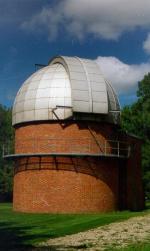| Warner and Swasey Observatory |
| Case Western Reserve University | Nassau Station |
| Visitors |
|
» Home » News » Gallery » Reference » Weather |
| Science Resources |
|
» NSRT User Interface » Software » Data Archive » Download Data |

|
 |

The main sequence is the place where stars spend the great majority of their lives. Somewhere between 80-90% of the stars that we observe near us are on the main sequence. This is the time when the star is burning hydrogen (hydrogen being converted into helium) via the proton-proton (p-p) chain in lower mass stars, and the carbon-nitrogen-oxygen (CNO) cycle in higher mass stars. For stars of solar mass, their main sequence lifetime is around 10 billion years (1010 years). Higher mass stars have shorter main sequence lifetimes, and are hotter and bluer, while lower mass stars are the exact opposite. As a star evolves more and more on the main sequence, it becomes larger, hotter, and more luminous.
Hot, blue giants make up one end of the main sequence, and cooler red dwarfs hold up the other end. Diagrams of older clusters are devoid of blue giants because they have already exhausted their hydrogen fuel and moved off the main sequence to the next part of their lives.
Higher mass stars have convective cores, so a constant mixing takes place. The result is a nearly homogenous core, and therefore very little hydrogen left over. Lower mass stars have radiative cores, so higher proportions of hydrogen stay around the core since there is no mechanism to bring it into the area where the nuclear reactions are taking place.
As stars burn certain elements, the star's composition changes, as does its spectrum.
On to the next stage of stellar evolution
Back to Stars page
Created by Marta Lewandowska, July 1999.
©1999 CWRU Astronomy Dept.
comments
Last modified July 1999
Case Western Reserve University